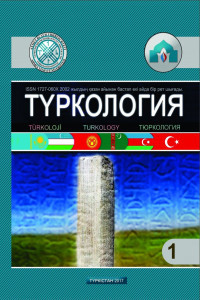THE TRANSITION TO THE LATIN ALPHABET IS A REQUIREMENT OF TIME
This article analyzes the significance of the transition of the Latin alphabet of the Republic of Kazakhstan. In our modern Cyrillic alphabet, the Kazakh language is represented by the official language of the Republic of Kazakhstan, as well as in Russia, Uzbekistan, China, Mongolia and other native Kazakhs living in the streets. The Kazakh language is attributed to the Kipchak group of Turkic languages, including the Kypchak-Nogai with Karakalpak, Nogai and Karachaevian languages. There are also ten other members of the Kyrgyz, Tatar, Bashkir, Karachaevo-Balkar, Crimean, Kazakh and Tatar languages. The Kazakh language is somewhat dissatisfied. In the history of the Kazakh alphabet system of the Kazakh language has passed several historical periods and nationalistic alphabets. In 1929, the Arabic writings were used in Kazakhstan. In the beginning of the twentieth century, Ahmet Baitursynov based on the excellence of the Kazakh phonetics, using the "direct writing" on the Arab graphics. The transition of the Latin alphabet is a great blessing for the Kazakh people, its roots and the flowering, and in the future they are building a large part of our country.
THE TRANSITION TO THE LATIN ALPHABET IS A REQUIREMENT OF TIME
This article analyzes the significance of the transition of the Latin alphabet of the Republic of Kazakhstan. In our modern Cyrillic alphabet, the Kazakh language is represented by the official language of the Republic of Kazakhstan, as well as in Russia, Uzbekistan, China, Mongolia and other native Kazakhs living in the streets. The Kazakh language is attributed to the Kipchak group of Turkic languages, including the Kypchak-Nogai with Karakalpak, Nogai and Karachaevian languages. There are also ten other members of the Kyrgyz, Tatar, Bashkir, Karachaevo-Balkar, Crimean, Kazakh and Tatar languages. The Kazakh language is somewhat dissatisfied. In the history of the Kazakh alphabet system of the Kazakh language has passed several historical periods and nationalistic alphabets. In 1929, the Arabic writings were used in Kazakhstan. In the beginning of the twentieth century, Ahmet Baitursynov based on the excellence of the Kazakh phonetics, using the "direct writing" on the Arab graphics. The transition of the Latin alphabet is a great blessing for the Kazakh people, its roots and the flowering, and in the future they are building a large part of our country.
___
- 1. Назарбаев Н. Ә. «Болашаққа бағдар: Рухани жаңғыру». Egemen.kz
- 2. Күдеринова Қ. Қазақ жазуының теориялық негіздері. – Алматы, 2010.
- 3. Ғали Ә. Латын әрпіне өту қазақ тілін кері шегіндіреді. http://qazaqtimes.com/article/8505.
- 4. Латын әліпбиіне көшуге қарсымыз. «Жалын» журналы, №3, 2013.
- 5. Айталы А. Қазақ тіліне сұраныс жоқ елде, латын әліпбиіне сұраныс бола ма? «Жалын» журналы, №3, 2013.
- 6. Әбілқасымов Б., Мәжітаева Ш. ХХ ғасырдағы қазақ әдеби тілі. – Астана: Елорда. – 2000.
- 7. Байтұрсынов А. Тіл тағылымы. – Алматы, 1992.
